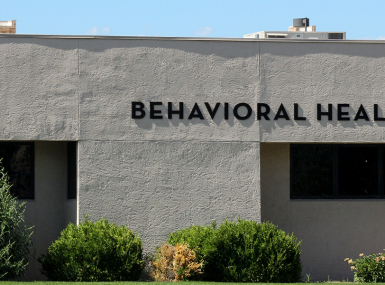Spotlighting Local Leadership: Strengthening the Behavioral Health Continuum of Care

Upcoming Events
Related News
Counties play a critical role in supporting community members living with a behavioral health condition or experiencing a behavioral health crisis. Annually, counties allocate $130 billion to community health systems – including behavioral health – and provide services through 750 behavioral health authorities and community providers. This funding supports prevention, treatment and recovery services as well as the elements of a continuum of care – someone to contact, someone to respond and a safe place for help – when people are experiencing a behavioral health crisis.
County leaders are successfully investing in and supporting a behavioral health continuum of care by communicating that provision of necessary services improves community mental health, saves taxpayer money, allows law enforcement to focus efforts on public safety responsibilities, reduces the overuse and misuse of the criminal legal system and decreases the reliance on emergency rooms.
The National Association of Counties (NACo) and National Association of County Behavioral Health and Developmental Disabilities Directors (NACBHDD) have collaborated to spotlight how local leaders – across roles and demographics – are advancing behavioral health care.
The following roles are highlighted in this report:
- County elected officials
- Behavioral health directors
- Rural and frontier county leaders, and
- Intellectual and developmental disability directors.
Introduction
Counties play a critical role in supporting community members living with a behavioral health condition or experiencing a behavioral health crisis. Annually, counties allocate $130 billion to community health systems – including behavioral health – and provide services through 750 behavioral health authorities and community providers. This funding supports prevention, treatment and recovery services as well as the elements of a continuum of care – someone to contact, someone to respond and a safe place for help – when people are experiencing a behavioral health crisis.
County leaders are successfully investing in and supporting a behavioral health continuum of care by communicating that provision of necessary services improves community mental health, saves taxpayer money, allows law enforcement to focus efforts on public safety responsibilities, reduces the overuse and misuse of the criminal legal system and decreases the reliance on emergency rooms.
The National Association of Counties (NACo) and National Association of County Behavioral Health and Developmental Disabilities Directors (NACBHDD) have collaborated to spotlight how local leaders – across roles and demographics – are advancing behavioral health care.
The following roles are highlighted in this report:
- County elected officials
- Behavioral health directors
- Rural and frontier county leaders, and
- Intellectual and developmental disability directors.
County Elected Officials
County elected officials serve as key leaders in developing and enhancing local behavioral health treatment to best serve all community members. As primary policy and funding decision-makers, elected officials may be responsible for identifying gaps in services, driving solutions and building stakeholder consensus, in addition to other roles. From passing resolutions to eliminate stigma, putting behavioral health levies on the ballot, supporting crisis triage centers and dedicating resources to community-based care, elected officials can cultivate support and funding for a robust, integrated, accessible and sustainable behavioral health continuum of care.
County Spotlight: Burlington County, N.J.
Population: 461,860

In 2021, Burlington County commissioners passed a resolution designating the county as stigma-free to combat misperceptions about behavioral health and increase awareness of local resources. The commissioners also created a Stigma-Free Task Force to develop actions the county can consider taking to engage and educate residents.
"By designating the county as stigma-free, we are declaring that there can be no health without mental health, and we will break down barriers our residents may face either before seeking treatment or in recovery."
County Spotlight: Douglas County, Neb.
Population: 584,526

To seek guidance and input from the community, Douglas County commissioners hosted a series of town halls to discuss if and how American Rescue Plan Act (ARPA) Recovery Funds should be spent on a mental health facility.
"There's a void, a gap. We're serving those individuals in our jail, and that's not appropriate. It is not something that we should continue to do."
County Spotlight: Saline County, Kan.
Population: 54,303

Saline County commissioners allocated nearly $200,000 from the county’s ARPA Recovery Funds to develop a co-responder program to partner a mental health clinician with law enforcement to de-escalate and triage mental health related calls. The program provides community-based care and connections to services, while avoiding unnecessary police response. Through a partnership between Central Kansas Mental Health Center, the Salina Police Department, Saline County Sheriff’s Office and Saline Fire Department, the program serviced over 1,000 individuals between 2023 and 2025, supported by the addition of a second co-responder team in 2024.
"Normally, you’re trying to weigh one side against the other, but in this case, there is no other side. We’ve been working on figuring out ways to do the compassionate thing and stop the revolving door of mentally ill patients coming to jail, getting out and coming back two days later. This isn’t being soft on crime. This is just trying to get folks to the right place where they can get help."
County Spotlight: San Miguel County, Colo.
Population: 8,072

After learning that one in five residents reported eight or more days of poor mental health in the past 30 days, San Miguel County commissioners passed a ballot resolution, later approved by 66 percent of voters, to create a behavioral health mill levy to fund local services. To enhance efforts, elected officials are developing partnerships across the continuum of care.
"That's a priority for me to get the behavioral health, and especially substance use disorder continuum of care, as formal of a partnership as possible, with our criminal justice system."
Behavioral Health Directors
County behavioral health directors serve a multifaceted role that varies depending on the authorities each state grants. These professionals play a crucial role in coordinating mental health and substance use prevention and treatment programs by leading their local agencies. Behavioral health directors promote wellness by administering Medicaid benefits, delivering high-quality services and educating the public about behavioral health conditions and available resources. They collaborate with first responders, including law enforcement and other social services systems, offering a range of options to support a continuum of care. Depending on the state, behavioral health directors can serve on local boards or committees related to mental health. These appointments empower them to influence policies and allocate resources.
County Spotlight: Chesterfield County, Va.
Population: 364,061

The Chesterfield Community Services Board (CCSB), also known as the Chesterfield Department of Mental Health Support Services, promotes the county’s wellbeing by collaborating with community partners and delivering safety-net services for residents. Since 2014, CCSB has partnered with local law enforcement, fire and emergency services and judicial agencies to provide Crisis Intervention Team (CIT) training to over 1,000 county personnel. This training laid the groundwork for further collaboration as the local crisis system continues to grow.
In response to state legislation, CCSB collaborated with Chesterfield County Police Department (CCPD) to develop protocols for responding to behavioral health crises. After developing these protocols, CCSB and the CCPD launched two Co-Response (CORE) teams, each with at least one clinician and one officer. The CORE teams reduce the role of police in behavioral health crisis response by shifting the primary responsibility to qualified behavioral health professionals, prioritizing de-escalation and non-lethal force. Calls are triaged through 988 and 911, with higher acuity calls routed to the CORE team.
“The success of this program is due to the collaboration and training that exists between our mental health clinicians and our public safety officers. They are an incredibly strong team that communicate and use their strengths and abilities to help each other while addressing individuals in crisis.”
– Kelly Fried, Executive Director, Chesterfield Community Services Board
County Spotlight: Harris County, Texas
Population: 4,835,124

In Harris County, the Clinician and Officer Remote Evaluation (CORE) program connects the Harris County Sheriff’s Office (HCSO) with crisis counselors from the Harris Center for Mental Health and Intellectual and Developmental Disabilities (the local mental health authority). The program delivers telehealth assistance via iPads during mental health-related calls, providing real-time assessments to determine appropriate actions and facilitate community-based follow-up care.
Available 24/7 to all county residents, CORE now includes 10 law enforcement agencies and over 350 iPads. In 2024, 11 percent of assessed individuals were transported to a hospital, and 33 percent of calls were resolved on-scene with subsequent follow-up from The Harris Center. This represents a decrease in hospital transport and an increase in on-scene resolutions compared to 2022, demonstrating the program’s effectiveness in diverting individuals from emergency care.
“At The Harris Center for Mental Health and IDD, we understand the critical intersection of mental health and public safety. The Clinician Officer Remote Evaluation (CORE) program provides an innovative solution that bridges the gap between law enforcement and mental health services. This collaboration not only assists deputies in making informed decisions but also significantly reduces the role of law enforcement in mental health crises. We are grateful for these partnerships that represent a vital step forward in responding to crisis mental health needs in Harris County.”
– Wayne Young, CEO, The Harris Center for Mental Health and Intellectual and Developmental Disabilities
County Spotlight: Orange County, Calif.
Population: 3,135,755

Orange County (OC) Health Care Agency provides mental health and recovery services, including crisis care. The agency operates a 24/7 crisis care continuum that includes a warmline and the local 988 Suicide Lifeline to deliver crisis stabilization services to callers. OC Health Care Agency leverages a digital system, OC Links, to share real-time information between participating agencies and connect clients to appropriate care. A bed availability dashboard expedites transport for individuals experiencing behavioral health emergencies to Crisis Stabilization Units (CSU’s) rather than to an emergency department or jail.
These efforts support the county’s broader goal of connecting individuals to appropriate levels of care. For example, call takers refer callers not in crisis to the warmline and routes those in crisis to 988. By offering alternative crisis response pathways, Orange County reduces strain on emergency services and prevents unnecessary incarcerations.
“We’re building a comprehensive closed-loop referrals platform that will connect our system of care. Replacing back-and-forth emails, phone calls, faxes and spreadsheets with a secure digital solution not only saves time, it saves lives by reducing the chance a person falls through the cracks during transitions in care.”
– Dr. Veronica Kelley, Director, OC Health Care Agency
Rural and Frontier County Leaders
Rural and frontier county leaders oversee the administration of services in counties with populations of 50,000 or fewer people. While only approximately 15 percent of the nation’s population lives in the 2,050 counties deemed ‘non-metropolitan’ or rural, these jurisdictions account for over 72 percent of the nation’s total land area. These counties face a distinct set of challenges compared to their urban counterparts; less densely populated jurisdictions’ resources must serve diverse populations spread out across large distances. Rural and frontier county leaders are finding innovative ways to provide services and adapt resources to their communities’ unique needs by utilizing clinical crisis response teams, expanding certified community behavioral health clinics (CCBHCs) and leveraging law enforcement partnerships with supplemental training.
County Spotlight: Benzie County, Mich.
Population: 17,970

To leverage existing resources across systems, Centra Wellness Network (CWN) – the publicly-funded community mental health service program in Benzie County – partnered with the Michigan Health Endowment Fund to establish the Rural Crisis Cross-Training Model. Established in 2023, this pilot program diverts individuals with mental illness from the criminal justice system through cross-sector partnerships between rural behavioral health providers and law enforcement. In this approach, designated law enforcement personnel receive 40 hours of Crisis Intervention Training (CIT) as well as information on available services, treatment interventions and how to document behavioral health contacts into CWN’s electronic health record. County 911 call center staff are also trained to recognize behavioral health-related calls and, if appropriate, to dispatch a CIT-trained officer. Once on the scene, the responding officer coordinates treatment with CWN’s Crisis Team.
Benzie County partners with neighboring Manistee County to support CWN’s operations. Both counties are represented on CWN’s Board of Directors by two county commissioners from each jurisdiction. As both counties are considered designated health provider shortage areas, this cross-system collaboration has been effective at connecting residents to care and addressing residents’ needs.
"This arrangement is a win/win for a community to find a safe, responsive and compassionate approach. Since going ‘live’ in January 2023, it has provided dispatch to inpatient behavioral health treatment, an incredible response time of one-hour and has diverted numerous individuals from incarceration to treatment by CWN and/or others."
–Joseph “Chip” Johnston, Executive Director of Centra Wellness Network
County Spotlight: Polk County, Minn.
Population: 31,192

In northwestern Minnesota, Alluma – a nonprofit behavioral health care organization that serves as the primary mental health crisis response provider for Polk County – made the decision to pursue CCBHC certification to better serve its surrounding communities. The CCBHC model was designed to ensure access to community-based coordinated behavioral health care, serve anyone who requests care for mental health or substance use (regardless of their ability to pay) and provide nine core services including 24/7 crisis services. In addition to meeting the model’s criteria, Alluma operates a 24/7 support and crisis helpline, a mobile crisis response team and a two-bed crisis stabilization unit where individuals can recover during a mental health crisis.
Originally a federal demonstration, CCBHCs like Alluma are now a Medical Assistance benefit in the state. Annually, Alluma serves upwards of 4,300 people across six different counties (Kittson, Mahnomen, Marshall, Norman, Polk and Red Lake) in northwestern Minnesota. The organization is also enrolled as a provider in the Minnesota Health Care Programs, which allows it to support individuals seeking care for substance use disorder through the state’s Behavioral Health Fund.
In 2023, Alluma screened 1,497 individuals through 3,497 calls into their crisis hotline. Of those individuals who completed a screening, 335 people (23 percent) received assessment, intervention or stabilization services.
“The CCBHC integrated model of care and crisis response services has been a game changer for the rural counties Alluma serves. We are excited to see the interest grow, more states and counties applying to be CCBHC states or receive SAMHSA grants so this model of care can be leveraged to provide a continuum of quality access to behavioral healthcare across the country.”
– Shauna Reitmeier, MSW, LICSW, Chief Executive Officer, Alluma, Inc.
County Spotlight: Sevier County, Utah
Population: 21,522

In partnership with five other central Utah counties, Sevier County established the Central Utah Counseling Center (CUCC) in 2006 as an interlocal agency to provide behavioral health care to the community. This agreement supports the involved counties in efficiently delivering care and facilitating the most effective use of their taxing authorities to their mutual advantage. One such benefit to come out of this arrangement is the mobile crisis outreach team (MCOT), which operates in all six counties.
The CUCC – a local mental health authority in rural Utah – established the MCOT in 2021 using state grant funding. The MCOT unit is made up of either a peer support counselor or a therapist and a case manager that can be deployed in response to community members experiencing a mental health or substance use crisis. This unit can be mobilized through calls to the crisis line or by law enforcement directly. In 2023, the MCOT responded to 705 calls for services with a median time of under 20 minutes. Most of these calls (59 percent) did not include law enforcement involvement. CUCC estimates that if the MCOT did not exist, up to 96 percent of these responses would have resulted in hospitalization or jail detention.
“Through the Mobile Crisis Outreach Team (MCOT) we connect clients to appropriate services. MCOT has also given law enforcement a tool to utilize when responding to mental health emergencies in the community that they are not equipped or comfortable handling. One local sheriff has commented that this program is the ‘best thing that we have ever done.’”
– Nathan Strait, Chief Executive Officer, Central Utah Counseling Center
Intellectual and Developmental Disability Directors
Intellectual and developmental disability directors (I/DD) work to support and maximize opportunities for community members with intellectual and developmental disabilities through building comprehensive continuums of care. By administrating services such as crisis stabilization, workforce support and home-based care, I/DD directors build systems that empower people with intellectual and developmental disabilities with dignity, independence and respect.
County Spotlight: Polk County, Iowa
Population: 492,401

In 2021, the U.S. Department of Justice released an investigative report regarding treatment of residents with I/DD in Iowa’s state-run institutional centers that concluded bias and lack of integration in community-based crisis services for people with I/DD. To address this need, Polk County contracted with Easterseals Iowa to implement a crisis stabilization program. Easterseals’ residential and community-based programs help bridge I/DD care by offering support services to adults and children, both during and following crises.
“As a region, we’re responsible for ensuring access to an array of mental health crisis supports and services. Shortly after this report came out, it became clear to us that it was important to partner with a crisis provider that not only provided critical mental health services, but also understood the unique needs of those with an intellectual or developmental disability.”
– Annie Uetz, CEO, Polk County Behavioral Health and Disability Services
County Spotlight: Champaign County, Ill.
Population: 205,865

Champaign County Developmental Disabilities Board and Champaign County Mental Health Board co-host an annual dis/ability Resource Expo event that is planned and prepared by members of the disability community and their supporters. The purpose of the Expo is to connect people with disabilities to empowering resources and build connections between the I/DD community, service providers and public service organizations. This popular event features a multitude of vendors, including advocacy groups, equipment merchants, artists and authors who have disabilities.
“The importance of putting these voices front and center extends beyond our I/DD service system focus and supports the explicit goals of county government and many partners, to make this community inclusive and welcoming. We learn so much – about what matters and what is most likely to help us achieve that – from listening to self-advocates and meeting them and their families during our annual event.”
– Lynn Canfield, Executive Director at Champaign County Mental Health Board and Champaign County Developmental Disabilities Board
County Spotlight: El Paso County, Texas
Population: 865,657

El Paso County has built a historic bridge between local mental health authorities and law enforcement by housing both Crisis Intervention Services for I/DD and mental health and Crisis Intervention Team (CIT) within the same Crisis Emergency Services division. This collaboration has improved the safety of individuals with I/DD through providing specialized training and resources to law enforcement to improve incident response after hours or when CIT is not available.
“As the Intellectual & Developmental Disabilities Authority for our community, [Emergence Health Network] is committed to offering services of the highest level of quality to individuals and families. We are extremely fortunate to have fantastic partners who devote valuable resources to ensure those with the highest need have access to specialized care.”
– Kristi Daugherty, CEO Emergence Health Network
Resource
Promoting Health and Safety Through a Behavioral Health Continuum of Care

Related News

Congress passes SUPPORT Act reauthorization
On September 18, the U.S. Senate passed the SUPPORT for Patients and Communities Reauthorization Act of 2025 (SUPPORT Act Reauthorization) (H.R. 2483) by voice vote, following House passage earlier this year. With strong bipartisan backing in both chambers, the legislation now heads to the President’s desk for signature.

SUPPORT Reauthorization Act of 2025: What it means for counties
On December 1, the bipartisan SUPPORT for Patients and Communities (SUPPORT) Reauthorization Act of 2025 (H.R. 2483) was signed into law. The reauthorization renews vital federal funding for programs that seek to prevent opioid overdoses and expand treatment and recovery options.

CMS announces new funding opportunity for the Innovation in Behavioral Health Model
On October 16, the Centers for Medicare & Medicaid Services (CMS) released a Notice of Funding Opportunity (NOFO) for Cohort II of the Innovation in Behavioral Health (IBH) Model. This new round of funding builds on the initial IBH model announced in 2024 and continues CMS’s efforts to improve outcomes for individuals with moderate to severe mental health conditions and substance use disorders (SUDs) by advancing integration between behavioral and physical healthcare.